Hello everyone, I hope you are all doing good.
Here I would like to share with you all about a place called Mamallapuram which is an ancient city with an important historical value. Come along with me as I'm going to say some interesting and fascinating monuments that standstill even today as a masterpiece for ancient architecture.
I was born in Chennai and the place I'm describing here is not that far from Chennai which is the capital city of Tamil Nadu a state in Southern India. Like any other big country, India is divided into 28 states and 7 Union Territories however there has been partitions made in the recent past and the total number of states has been made even higher. I was born in the state of Tamil Nadu that is found at the most distal end of India making the tip of the Indian peninsula.
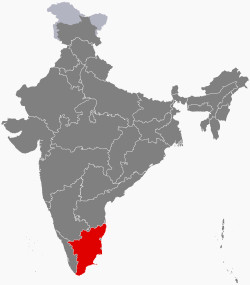
Source
Región de Tamil Nadu de Filpro
The region of Tamil Nadu as I have mentioned in my previous articles have been ruled by three great Kings of all time who ruled different parts of Tamil Nadu during different time periods. They are commonly called as the Cholas, Cheras and Pandiyas. These three great kings were known for their bravery, wisdom and the way they ruled the people. It was during their period the southern India, especially the present Tamil Nadu, flourished.
Mamallapuram also called as Mahabalipuram is an ancient town that served as a port during the seventh century. It was built during the period of the great Pallava Dynasty and the King who was on the throne during this time period was Narashimavarman I. Going deep into the history of the place several facts get revealed. The Pallava King is considered to be the person who started to develop the city of Mamallapuram. The entire place has several rock cut monuments. Several mandapa's, shrines some shaped in the form of chariots were made from granite rocks. The world famous Shore Temple located in Mamallapuram is carved out of dressed stone. There are many bas-reliefs in the Shore Temple among which one such relief is carved out of granite rock. This is a massive relief measuring 100 feet in length and 45 feet in height. Some of the ratha's or chariots resemble the buddhist vihara or chaitanya hall architecture. Some historians also say that they resemble the rock carvings in Ajanta and Ellora caves. This is because the Pallava King invaded King Pulakesin who was the ruler of the region were the caves is present. After being victorious in his battle, it is believed the Pallava King bought some architects from the region to Mamallapuram to design the place. It is also said that a part of this area served as a school for teaching young sculptors who were mastering different forms of architecture. This is most obvious from having a look at the Pancha Ratha which means Five Charriots where each one is carved in a different style but the whole thing is carved out of a single stone of granite. This place has been recognised as a World Heritage Site by the UNESCO.
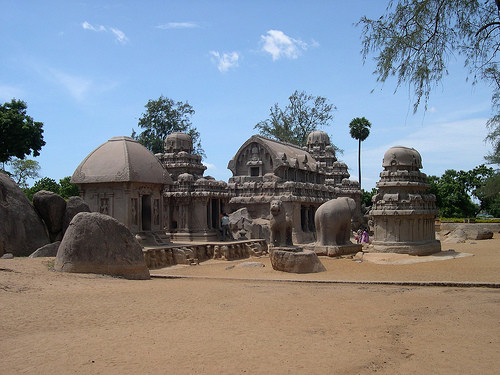
Source
Pancha Ratha de Arupparia
Getting to Mamallapuram is not a tough job but it still takes a little time. From Chennai city there are city buses available much often to Mamallapuram. Direct buses start from the Central Mofffusil Bus Terminus abbreviated as CMBT which by itself is the largest bus terminus in whole Asia. Apart from these buses all the buses that have a route marker as ECR will take you to Mamallapuram. The difference is that the buses marked ECR will not take you deep into the exact spot. It would take an hour or two for you to reach Mamallapuram depending on the busy Chennai traffic that is really hard to get through. Buses are also available from other important places within the city and also from Pondicherry.
There are several monuments of tourist interest to visit in Mamallapuram. There are about nine rock cut caves in the temples. A cave called Mahishashura mardhini cave which depicts a goddess fighting against a demon along with Lord Vishnu having a cosmic sleep is a noteworthy one.
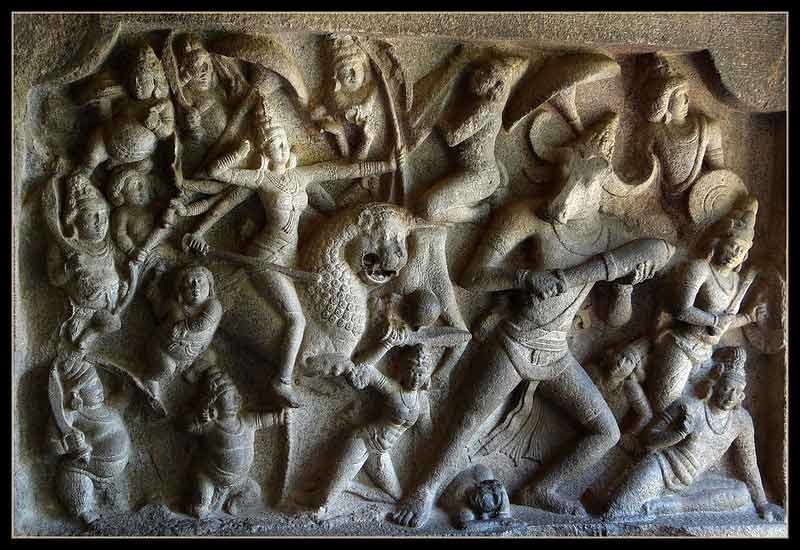
Source
Relieve del a Diosa Durga en la cueva Mahishashura Mardini
The Pancha Rathas or the Five Charriots [literal meaning] was built in the 7th century by the famous Pallava King Narashimavarman I. The temples of the five chariots are unfinished and therefore they were never used to be worshipped. The name was given after Draupadi and Pandavas who were important characters in the ancient history of Hindus however the name and the temple doesn't have any connection. The five rathas are named as Draupadi ratha, Arjuna ratha, Bhima ratha, Dharmaraja Ratha, Nakula Sahadeva Ratha. The major architectural beauty about this monument is that each of the chariot is unique and the pattern used by the five chariots appeared in the temples design that followed with little variation for about a thousand years.
Draupadi ratha us the smallest and the simplest ratha among the five chariots. This chariot is offered to Goddess Durga and even the carvings on the outside resemble the Goddess. Inside of the Draupadi ratha Goddess Durga is surrounded by her devotees. One of the carvings depict a devotee cutting off his head by himself to give as a offering to the Goddess. It is believed that such acts took place in Durga temples in the ancient times but not that often.

Source
Draupadi ratha de Av. kumar 85
The Arjuna ratha is built resembling a place in its miniature form with carvings throughout its walls. The dome is octagonal in shape which later became a classic roof for most temples in the region. Inside the chariot is Lord Shiva with his leg crossed leaning against Nandhi which is his steed. There is a Nandhi sculpture behind the ratha which is sitting.

Source
Arjuna Ratha de IM3847
Nakula Sahadeva ratha is the only ratha among the five that faces south all others face west. It has a barrel roof and apsidal shape. The back part of the ratha lies in the same line with the rear end of an elephant located there.
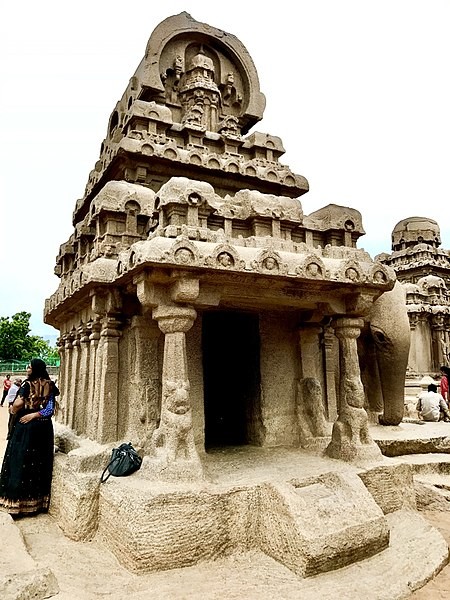
Source
Nakula Sahadeva Ratha de IM3847
Bhima ratha is a long ratha among all others and has a palace architecture with four column pillars in the front. The pillars have carvings of Lions facing front.

Source
Bhima ratha de Zuhebkhan94
Dharmaraja ratha is an incomplete ratha which resembles the Arjuna ratha but it is bigger than the Arjuna ratha. The dome of the temple is octagonal shaped and it remained as a miniature model of later temples with false windows, horse-shoe shaped arches, little rooflets etc.
Dharmaraja ratha has a sculpture of Lord Vishnu engraved in its wall which is obviously visible from the chakra and club. There are also some controversies that the sculptur may be Lord Shiva seeing from another aspect. Right above the inscription there is an inscription engraved in the wall. Dharmaraja ratha also bears a sculpture of the King Mamallan with Gods on the four corners. The sculpture looks majestic but since it is present in the Yama or the God of Death corner it is considered as a funeral sculpture of this great king.
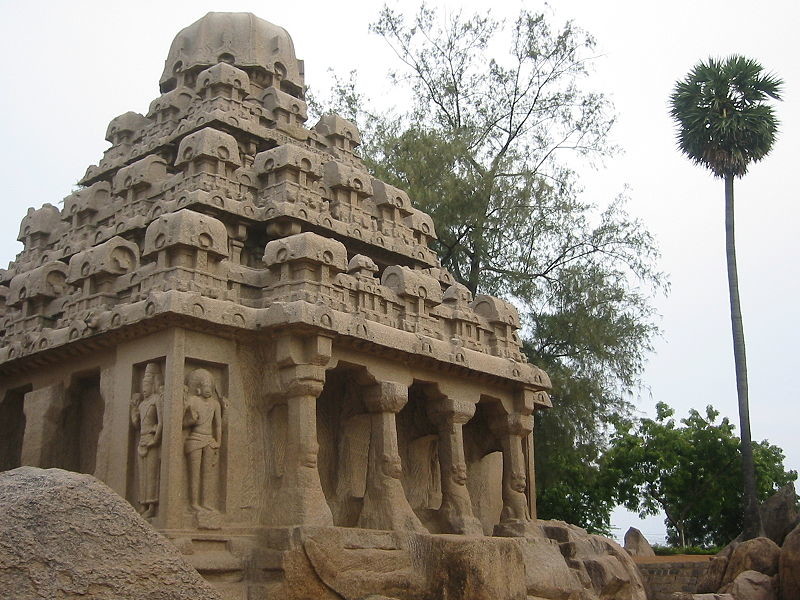
Source
Dharmaraja ratha de Leduardo
Near the Pancha Ratha there is a stone in which a Finial is carved and left there. It is considered that this was the time when the work in the Mamallapuram temple complex stopped. Without a finial on its place in the top of a temple it can't be consecrated. This is why the Panca Ratha has never been worshipped by the people.
The next important monument is the Shore Temple in Mamallapuram. It was built by a King called Rajasimha who was also a Pallava King. The temple is dedicated to Lord Vishnu and Lord Shiva. A prominent structure in the temple is its wall which has Nandi on top of it which is believed to be the steed of Shiva according to Hinduism.
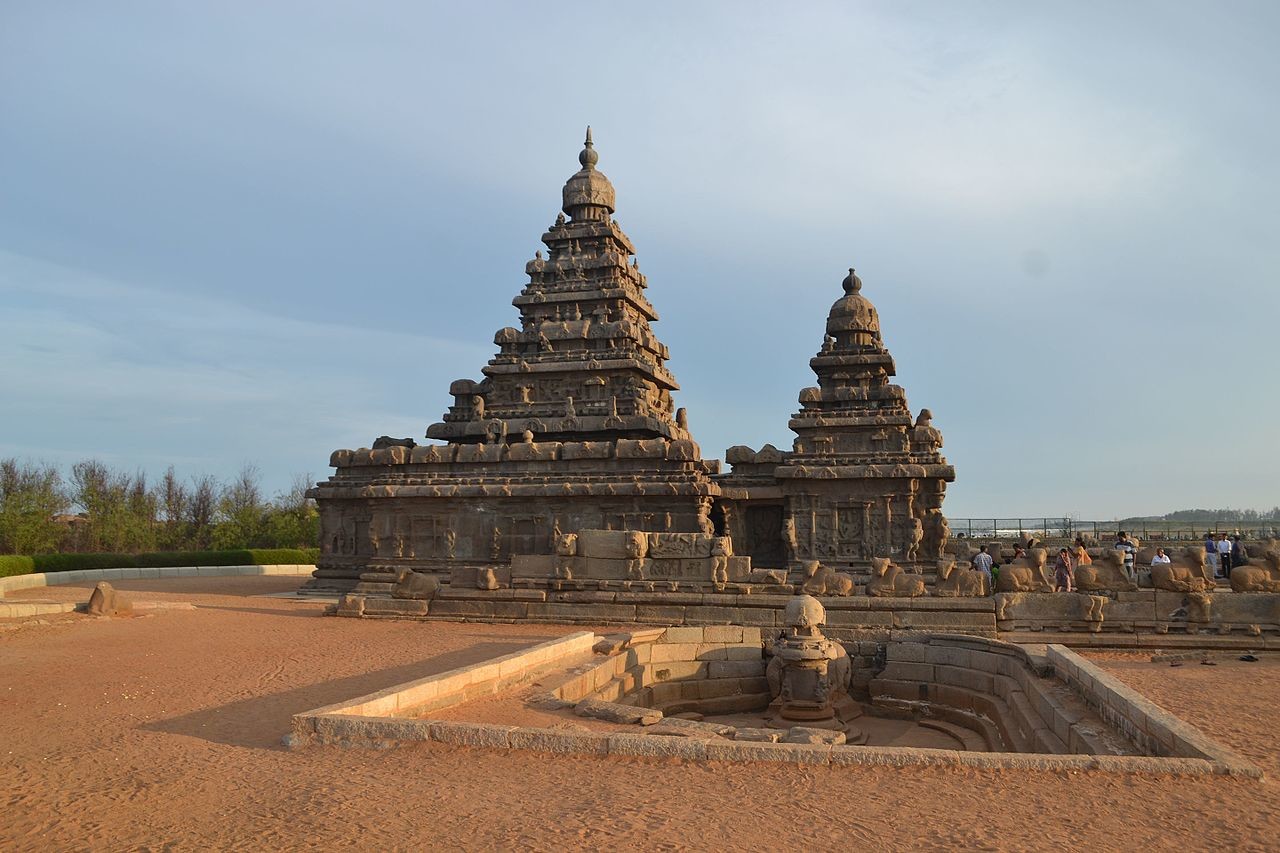
Source
Templo de la Orilla de Kavita Modi
There are two towers that are in the shape of a pyramid with octagonal domes. The sea is given its name as the Shore Temple because it is situated on the shores of the mighty Bay Of Bengal. Due to its close proximity with the sea some of the architectural wonders is considered to be eroded by the sea. The region of Mamallapuram as I said before was an importan Port City during the rule of Pallavas in Kanchipuram. The towers of the shore temple also resembles the Pancha Rathas except the fact that the shore temple has the finials in its place which means that the temple was consecrated and worshipped by the people. The pillars consists of engraved Lions as in Pancha Ratha. There is a scultpture of the Goddess Durga sitting in her steed Lion with a small hole in the Lion's chest in the shore temple.
Another important monument in Mamallapuram is the Arjuna's Relief. It is an amazing relief that measures 100 feets in length and 45 feet in height. The picture that is depicted is considered to be Arjuna's penance or the Descent of Ganges. Normally its both that is depicted in this relief. Arjuna's Penance describes the story how Arjuna one of the five pandava brothers did some extraordinary stunts to recieve blessigns from God and to get a powerful weapon from Lord Shiva. The next one about the Descent of Ganges also deals with a similar story. It portraits how Bhagiratha did some fascinating things to bring the holy river Ganges down to Earth. The Ganges has to be first stopped by Lord Shiva by his hair or else the Earth would not be able to bear the Ganges.
The relief consists of the important elements of the story in the left and the scenes in the right. The two scenes are seperated by a line made of carved nagas or snakes. In the right side there are elephants carved on the rock that protects its young ones fromother animals in the forest. The artistical beauty of the place can't be just explained in wordfs or by photographs standing from the ground one can't even touch the feet of the elephants. The carvings are so realistic, vivid and natural. The pose of Arjuna in the carving is a yoga posture that is too difficult to perform as the person has to stand in one leg without moving and according to the chronicles Arjuna stood there till God appeared in front of him to grant his wish. There is a scultpture of Lord Shiva in the relief granting his wish to Arjuna and right below it there is a sculpture of Vishnu shrine with people worshiping it. There are bunch of celestial sculptures on the right side of the relief with no humans. This symbolizes the celestial world.

Source
El descenso del Ganges (Penitencia de Arjuna) de Bernard Gagnon
The other important monument in Mamallapuram is the Varaha cave temple which is considered to be built during the 7th century. It is built of pillars with a roof that has the design of temples carved in it. The pillars also have Lion sculptures in them resembling the ones in Pancha Ratha. There is a depiction of the story Varaha saving the Goddess of Earth Bhuma Devi from the Naga King who kidnapped Bhuma Devi deep under the oceans. A similar kind of depiction is made in another place in India called as the Udayagiri Sculpture made by the Gupta Empire. Comparing the natural vivid look of Varaha in Mamallapuram to the Udayagiri Sculpture clearly states that the Pallava's where far ahead in art than the Gupta's. There is also another depiction of an devotee offering his head to Goddess Durga as a sacrifice which is very similar to the one that is found in Pancha Ratha, even in this temple.
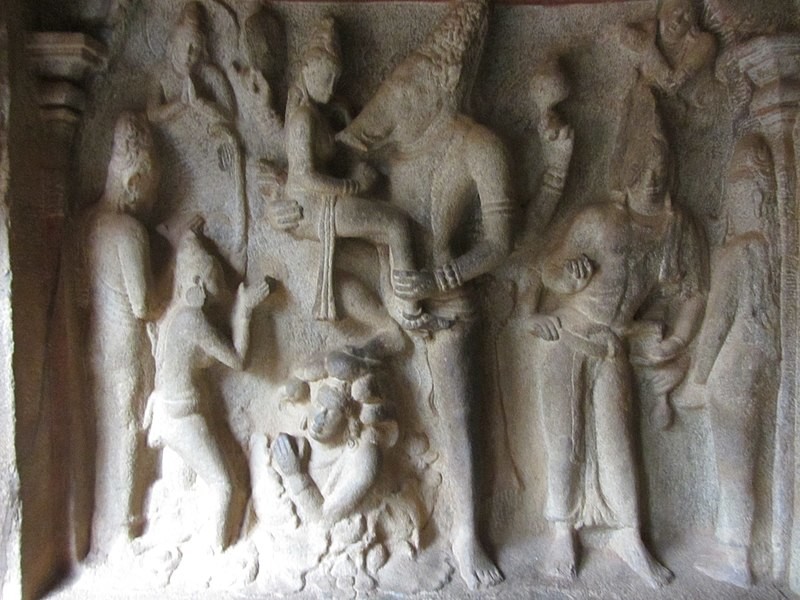
Source
Avatar de Varaha Vishnu salvando a la Diosa de la Tierra Bhudevi del Mar de Sengai Podhuvan
Another beautiful rock work in Mamallapuram is the Krishna Mandapam which contains a relief that depicts the scene when Krishna lifted a mountain called Govardhanagiri in order to protect people from a storm. There are few pillars found in front of the relief.
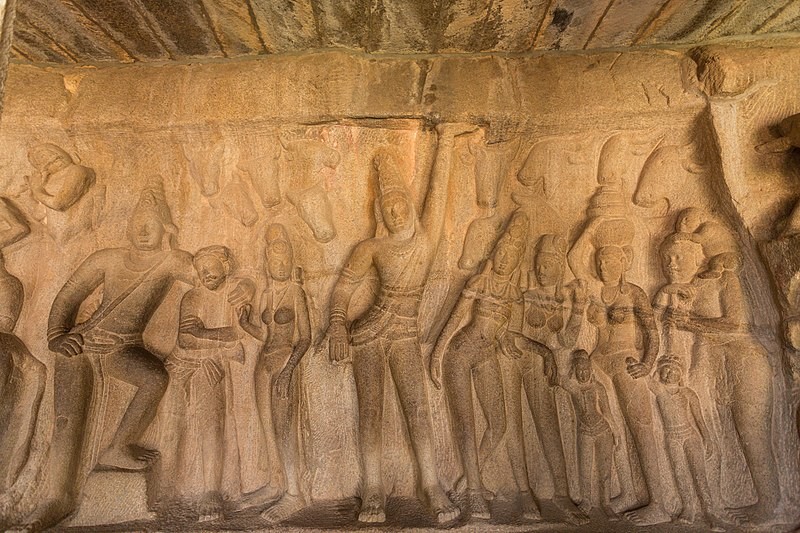
Source
Krishna Mandapam de Samrajclicks
Another part of the mandapa or mandapam depicts a scene where a milkmaid milks a cow with a calf in front to enhance the cow's milk production. This symbolizes the close association of the Cow as a Hindu God.
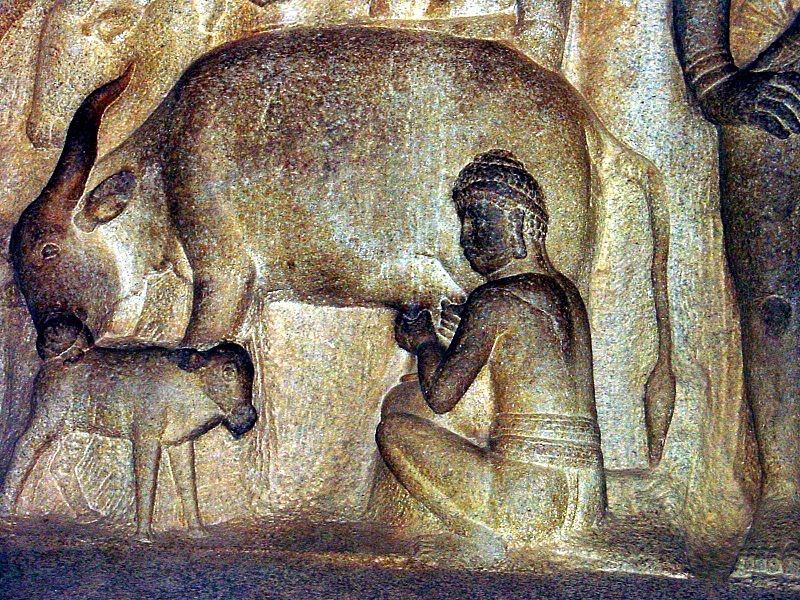
Source
Escena de ordeñamiento de G41rn8
There is a famous boulder called as the Krishna's Butter Ball in Mamallapuram. The gigantic boulder rests in a small rock and from the time of Pallava's no one could move the boulder even by an inch. Even the gigantic Elephants were not able to do it.
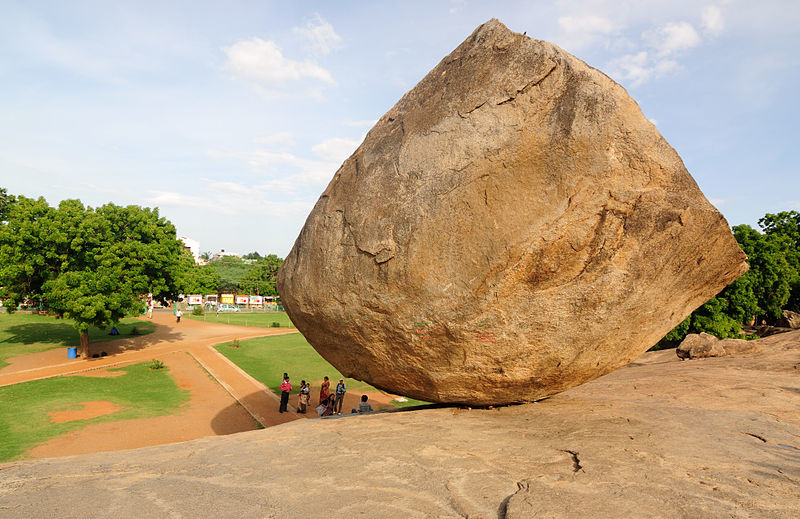
Source
La bola de Mantequilla de Krishna de Dey. sandip
Travelling a little distance from this temple complex you could find another monument called as the Tiger's cave which is located near the shore. It is considered to be a place where cultural festivals were conducted during the Pallava period.
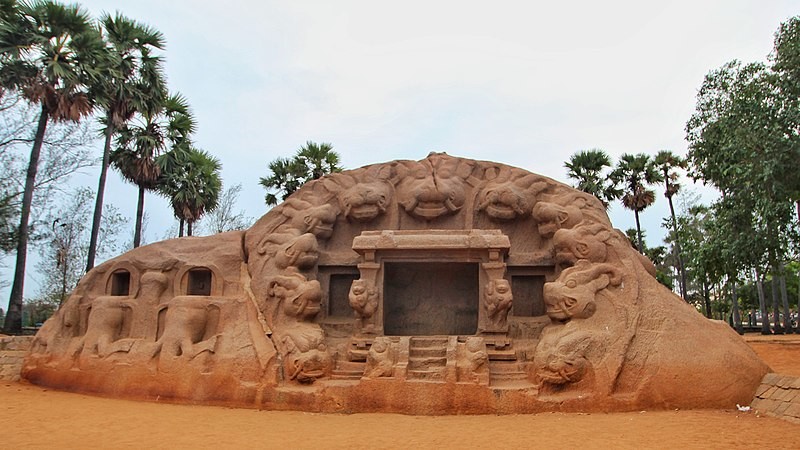
Source
La Cueva del tigre de Ksaravanakumar
The monument complex of Mamallapuram is a real master piece of ancient art work and till today portrays the courage, spirituality and cultural heritage the Pallava's preserved and developed. This is a must visit place if you visit the Southern Part of India with its scenic beauty the place is just amazing.
Thanks for reading and cheers..! :)
